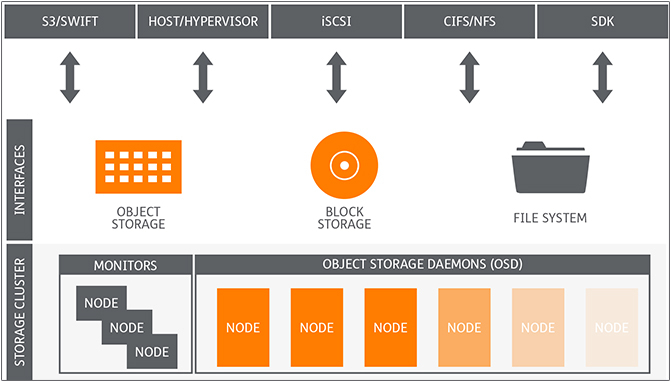Dream server incl.
Windows Server 2022 Essentials
Rack system, tower or microserver? You decide!

Many companies prefer object-based storage when building large, highly-scalable storage systems as this allows the data volumes to be managed much more efficiently. These systems separate the addressing of the object from the corresponding hardware, which greatly simplifies data migration.
The Crush algorithm from Ceph frees storage systems from the limitation of centrally managed identification tables. This significantly enhances both scalability and speed. A Ceph cluster manages the replication and balance of the data – completely independently and dynamically – without requiring an administrator's involvement in these time-consuming activities. This means that the software automatically distributes and replicates data in the event of unplanned failures of individual drives or entire nodes, as well as when modifying or expanding the storage.
With these server modules, complex storage systems can be easily created that are very powerful and open in their architecture. To simplify the selection for your Ceph cluster, we offer you basic minimum requirements for both monitor (MON) and OSD nodes.
Monitor nodes are tasked with monitoring the system and act as the central management for the Ceph cluster. These servers can also be operated virtually, though, the use of one to three physical monitor nodes is recommended. OSD nodes provide the actual data storage for the objects and can be scaled according to the desired redundancy level. For a replication factor of three, for instance, one will need at least three OSD nodes.
For more technical information on Ceph, please visit our wiki.
Monitor nodes are tasked with monitoring the system and act as the central management for the Ceph cluster. These servers can also be operated virtually, though, the use of one to three physical monitor nodes is recommended. OSD nodes provide the actual data storage for the objects and can be scaled according to the desired redundancy level. For a replication factor of three, for instance, one will need at least three OSD nodes.
Virtualization is becoming increasingly important in the modern IT infrastructure. Hardware independence and lower energy consumption levels allow companies to drastically save on costs. Our appliance allows you to benefit from the advantages of two software solutions: Ceph, a software for virtually limitless storage, and Proxmox, an open source platform for server virtualization. With our Proxmox Ceph appliance, we have created a hardware and software bundle that makes it easy to store virtual machines (VMs) on Ceph-based data storage nodes. The versatile appliance is a redundant and highly available storage system (live migration, storage, migration and no single point of failure) that also offers the same server virtualization advantages as our other Proxmox-optimized systems.
For more technical information on Ceph, please visit our wiki.